Abstract: The development of reading skills from early levels is the key tool to success not only in the academic context; but also for personal development. Reading at literal level is the starting point where students get the basic skills to develop comprehension reading skills at a higher level. The purpose of this study was identify the extent to which English teachers from elementary level groups of English as a Foreign Language (EFL) are aware of the effect of the implementation of Differentiated Instruction (DI) on the reading skills development. A total of 20 EFL teachers were surveyed in this investigation. Initially, teachers were asked to answer some questions about differentiated instruction, and later on, students of an experimental group were tested after the implementation of DI. The results showed a positive impact of DI on the development of reading skills, since there was a significant gain in the post test scores. There was also evidence of lack of awareness teachers have about the positive effect that DI has on the development of reading skills. The differentiated strategies met students? needs, readiness level, learning styles and interests. Working under different modalities made students´ engagement easier through the implementation of differentiated reading modalities: peer reading, reading in groups, reading alone and reading for fluency. The teacher assisted the learners through the processes of content differentiation, process and product presentations. As a result, it was found advisable to apply a replica of this quasi-experiment to students of higher levels to see and confirm the great benefits of the implementation of Differentiated Instruction on the development of reading skills. Finally, based on the findings from questions were teachers were asked about DI, an e-book with differentiated strategies was developed to encourage and guide its implementation.
Keywords: Differentiated instruction,Learning styles,Readiness level,Reading skills,Tiered Assignments.
Resumen: El desarrollo de habilidades de lectura desde los primeros niveles es la herramienta clave para el éxito, no solo en el contexto académico, sino también para el desarrollo personal. Leer a un nivel literal es el punto de partida para que los estudiantes adquieran los conocimientos básicos para desarrollar habilidades de comprensión lectora en niveles avanzados. El propósito de esta investigación fue identificar hasta qué punto los profesores de Inglés de los niveles principiantes de estudiantes de Inglés como lengua extranjera conocen los efectos de la implementación de la Instrucción Diferenciada (DI por sus siglas en Inglés) en el desarrollo de las destrezas de Lectura. A total of 20 EFL teachers were surveyed in this investigation. Initially, teachers were asked to answer some questions about differentiated instruction, and later on, students of an experimental group were tested after the implementation of DI. Un total de 20 profesores de inglés como lengua extranjera participaron en esta investigación. Inicialmente, se les pidió a los profesores contestas preguntas acerca de la instrucción diferenciada, y después, los estudiantes de un grupo experimental fueron evaluados, después de haber sido intervenidos. Los resultados mostraron que el impacto del uso de DI tuvo un impacto positivo desarrollo de destrezas de lectura, ya que hubo un mejoramiento notable en los promedios de evaluaciones. Así mismo, se encontró evidencia de falta de conocimiento de los profesores acerca de los posibles efectos positivos del uso de la instrucción diferenciada en el desarrollo de las destrezas de lectura. Las estrategias diferenciadas cubrieron las necesidades, el nivel de preparación, los estilos de aprendizaje y los intereses de los estudiantes. El trabajar en diferentes modalidades facilitó la participación de los estudiantes en las actividades de lectura en pares, en grupos, personal y de lectura con fluidez. El maestro asistió el aprendizaje de los estudiantes a través de la diferenciación del contenido, el en proceso y en la presentación de productos. Como resultado, se halló aconsejable aplicar una réplica de esta investigación cuasi-experimental con los estudiantes de niveles avanzados para verificar y confirmar los grandes beneficios de la implementación de DI en el desarrollo de las habilidades de lectura. Finalmente, basado en la información obtenida en la encuesta realizada a los profesores, se elaboró un libro electrónico con estrategias diferenciadas para guiar y alentar la implementación de ID.
Palabras clave: Instrucción Diferencias, Estilos de aprendizaje, Estrategias de andamiaje, Habilidades de lectura, Tareas niveladas.
Investigacion
Differentiated instruction on reading skills at higher Education Level
Instrucción diferenciada sobre habilidades de lectura a nivel de Educación Superior
Received: 20 May 2019
Accepted: 28 June 2019

Teaching English as a Second or Foreign Language has experienced important changes over the centuries. There has been a transition from grammar-focused instruction to a more communicative approach. Theisen (2002)says that due to continual advances in digital technology, new ways for teaching and learning have emerged; therefore; language teachers have been adapting to the new methods or approaches. However, English classes are often teacher-centered, one size fits all. This means that most educators teach and assess all students in the same way: using the same materials, tasks and the same instruments for all kind of learners. Local studies have concluded that most English classes used the grammar translation method without an active involvement of Students did not take in the learning process. Classes were more teacher-focused ( Leon, 2013). Yet, in Higher Education level, there is a common to see a lecture-style classes, a transmission-oriented approach which does not efficiently promote students? learning ( Samuelowiczs, K. & Bain, J.D 2001). Educators assume that college students are autonomus, and they do not need any type of differentiation during the teaching-learning process.However, there are students who struggle to learn a foreign language due to different reasons. One could be that learners come from different educational backgrounds, some of which have poor reading skills even in their mother tongue.
In 2011, The Ecuadorian government offered scholarships to high school teachers to be trained in some Universities of the Unites States. Those who benefited from the Go teacher Program were introduced to Differentiated Instruction, and consequently, some years later this teaching approach started to be implemented in different schools, high schools and higher Education institutions, such as the Languages Center at Universidad Técnica de Ambato; whereas in the USA, at Elementary and High school levels, DI has been used since 1999. Carol Ann Tomlinson is considered the mother of this approach. Tomlinson developed the DI approach being made aware of the cognitive differences among students. Healey (2016)affirms that students are engaged and willing to learn when teachers differentiate instruction. She also states that DI can help educators to respond to learner?s different language skills. When DI is used in the classroom, learners feel empowered and motivated to keep doing their best.
Undoubtedly, developing students? reading skills is an issue that most English teachers encounter. There is evidence that students of starter level (A1 according to the European framework of languages) do not like reading. This lack of interest affects reading and the types of reading activities used in class is another factor that negatively contributes to this problem. Learners do not do the reading comprehension activities because they are not always graded or simple the activities do not fulfill students? real needs.
Doubtless, an English as a Foreign Language (EFL) class is not homogenous. It is heterogeneous, which means there are different students with different needs, abilities and interests. Then, high and low achievers can not read the same passage and do the same activities. For instance, high achievers get bored doing easy tasks because they do not see they are making progress in their learning, while lower achievers feel demotivated because the reading level is not graded. For this reason, the purpose of this study was to observe the extent to which EFL teachers are aware of the benefits of the implementation of Differentiated Instruction (DI) and analyze whether it has any impact on reading skills development.
The approach of Differentiated Instruction first appeared in the late 1990s in the USA. It was defined as a process of tailoring instruction to meet individual needs by using ongoing assessment and flexible grouping, where students support each other and share responsibility. It also requires teachers to pay attention to students? learning styles to meet their needs (Tomlinson, 2001).
Tomlinson C. A., (2013) and Weselby, (2014) suggest four ways to differentiate instruction. This DI is based on content, process, product, and affect/environment.
It refers to the knowledge, understanding, and skills teachers want their students to learn.
It is proposed to use a variety of instructional approaches, adapt class activities to meet the needs of their students, continually assess students to determine their readiness levels to inform if our curriculum and teaching method is working, and also offer a variety of opportunities for students to learn and, from there, demonstrate their knowledge. It also offers ways to present the material to be taught in multiple ways. Gregory and Chapman (2007) point out that the differentiated class is one in which teachers respond to the different needs of the student´s needs.
The ideal conditions for learning a new language are those derived from direct contact with it in real and significant communicative situations (Krashen, 1981). Creating those ideal conditions for students with different skills is the goal of every teacher. The studies that have been carried out to determine the effectiveness of significant communicative situations have concluded that they encourage higher level of linguistic development in certain areas such as fluency, pronunciation, lexical development, among others (Segalowitz, 1993).
It is how students come to understand or make sense of the content. It means that students must use their knowledge, understanding and skills to retain, apply, transfer and realize the practically of content in the outside real world.
The context refers to the place of construction of knowledge and the conditions of socialization that characterize the teaching-learning process of the foreign language. In addition, several educational systems and teacher training centers consider the two forms of acquisition and teaching-learning of the foreign language. The classroom (mix-ability), the teacher (Type of Instruction adopted) and the didactic material (differentiated material) are three constituent elements of the formal environment.
Schwartz (2005) mentions that the amount and style of teacher?s talk may vary the moment teacher provides helpful input. At the same time, breaking the information into chunks or smaller pieces explanations to learners contributes to students? understanding of context content.
The Differentiated Assessment respects the student with special educational needs from their individual reality, adapting or reformulating the instruments or evaluation modalities applied, in order to favor an effective evaluation of that particular student.
A product applies and extends what students have learned over a period. Students need to understand key ideas, transfer knowledge, and apply skills. Product differentiation refers to how students? emotions and feelings impact their learning.
The application of these methodologies allows students to do their communicative tasks using the elements of the language learned in previous classes or in other sources of information. Learners get in touch with authentic idiomatic structures and raise the quality of English language learning.
A quasi-experimental investigation was carried out for the present work. There were two groups involved in this study: a group of 20 EFL teachers who were asked about DI and whether or not they use it, and an experimental group of A1 level of EFL students which had the implementation of Differentiated Instruction approach for all their reading lessons. These students were evaluated after intervention with a post-test to see if DI had any effect on the reading skills. The experimental group of students was chosen in non-aleatory intentional way, according to the convenience of the researchers.
The information obtained from the post intervention test was compared to that found in the diagnostic test that is usually administered at the beginning of the semester. Most students showed to have low grades and even there were 10 students who did not answer the questions on the reading skill section of the diagnostic test. These results were a good starting point to finally see that there was an increase of score after the implementation of DI.
The reading sessions aimed to develop students? reading skills using differentiated instruction and to assists students to become independent learners of English. Allowing students to choose their own groups to work with was appropriate because it permitted the teacher to assist and assess their reading content easily. The classroom arrangement looked different; all students were reading the same texts; however, the kind of reading tasks were graded according to the students? reading ability. Due to the fact that most of students from the experimental group found the passages from their textbook quite boring, a variety of extra reading material was incorporated during the reading lessons but also varied reading activities as part of the intervention. This group of students were thought with DI approach, which is student-centered, during all their reading lessons for 12 weeks. All students read the same reading material, but they were grouped under different reading modalities, interests, learning preferences and they were reading at their own pace. Additionally, after checking students? diagnosis quiz results, the class was divided in three big groups: high achievers, quite good achievers and low achievers to work with the following strategies:
Students worked with different reading material (in length) both good and quite good students read a text of 250-300 words and answer 10 comprehension questions whereas the students below average read small texts of 150-160 words and with very simple language and answer 3-5 comprehension questions.
A second way of implementing differentiated instruction on reading skills was differentiating instruction by learning outcomes. Once the teacher knew about the student?s needs, learning preferences and learning styles and interest. Teacher designed outcomes by using the Bloom Taxonomy. Students with low reading ability did much recognizing task, the average learners did a little more of analysis and the gifted learners which were few in the class, did more of evaluating or justifying tasks.
The whole class was divided in three big groups: the source -dictionary group, the audio text group and the comprehension reading question group. Students rotate to different modalities. For instance, the source dictionary group of students looked up the meaning of new words before they read the text, once the finished they moved to the audio text group, where they listened to the audio while they were reading. They listened to the story twice and highlighted main facts about the story and finally they moved to the comprehension question group where students were given 5 questions to answer.
Most of the reading tasks were designed to activate both parts of the brain, the right and left hemispheres. The experimental group was arranged to work on their reading sessions based on the brain dominance, and there was also one additional group who did fluency reading practice and comprehension practice.
Group I left hemisphere learners were engaged on reading and doing tasks that involved information processing, logical, and sequential. For instance, this group of students liked reading texts alone or in pairs. They answered comprehension questions, wrote their own questions to assess their peers` understanding.
Group II right hemisphere students whose main characteristic was that they needed to think in pictures rather than in words. They liked reading texts, underlining, and highlight main ideas and to summarize it, some others drew main ideas, concepts, or new vocabulary the encountered when they were reading.
Group III Fluency practice, this modality was for students who wanted to improve their reading aloud, they wanted to articulate new words, read with intonation and rhythm. They had to take turns to read the whole passage while highlighting the words which were mispronounced or omitted. Then they practiced reading aloud, once they improved pronouncing all words from the text, they answered some comprehension question about the text.
To determine whether Differentiated instruction influenced Reading skills development of A1 EFL students at the Language Center- Universidad Técnica de Ambato, the post test was applied after the intervention, which consisted of different differentiated reading activities based on the content, process, product and assessment.
The reading skills development was measured through a numerical scale and the paired sample Student t-test was applied to verify the hypothesis.
This paper intended to find the extent to which English teachers from elementary level groups of EFL are aware of the effect of the implementation of Differentiated Instruction on the reading skills development, and additionally, it was confirmed that the use of DI has a positive impact on the development of reading skills.
For the purpose of this study, 4 questions from the questionnaire applied to teachers will be presented.
QUESTION 1
Choose the resources you use in reading instruction:
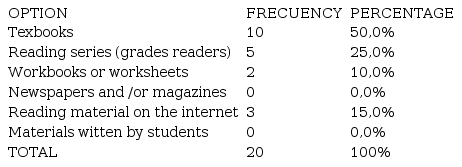
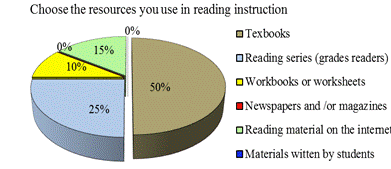
Analysis and Interpretation
The results reflect that, 50 % of teachers say that they basically use textbooks in reading instruction, while 25 % work with reading series, 15 % employ reading material on the internet, 10 % use workbooks or worksheets, and nobody consider newspaper, magazines and materials written by students. Paying attention to the outcomes showed above, teachers use textbooks as the main resources to teach reading. There is a lack of extra reading resources such as newspaper, magazines and materials prepared by the students themselves.
QUESTION 2
When you instruct reading and/or do reading activities, how do you organize students in the class?

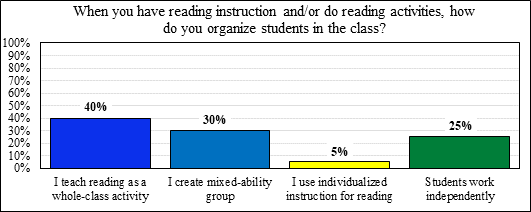
Analysis and Interpretation
The results reflect that, 40 % of teachers instruct reading as a whole-class activity, meanwhile 30 % create mixed-ability groups, 25 % ask students to work independently, and 5 % instruct students individually. There are differences between the ways in which teachers organize students in the class. However, it is observed that there is little reception of individualized instruction for reading.
QUESTION 3
After students have read something, what do they usually do?

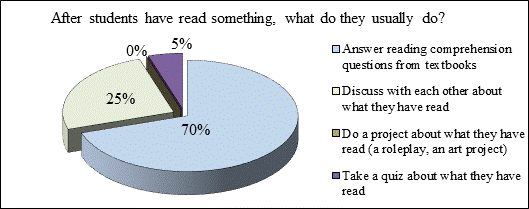
Analysis and Interpretation
With regards to this question, 70 % of teachers ask students to answer reading comprehension questions from textbooks, 25 % encourage students to discuss with each other about what they have read, and 5 % take a quiz about what students have read. Nobody requests that students do a project about what they have read (a roleplay, an art project).
Most of teachers ask students to answer some comprehension questions from their textbooks to measure their understanding or sometimes teachers generate discussions among students about the what they read, However, doing projects, involved students on hand on activities should also be promoted.
QUESTION 4
I know how to implement differentiated instruction to improve students´ readings skills.

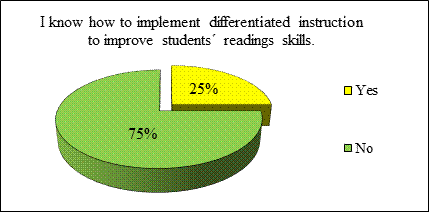
Analysis and Interpretation
About 75 % of teacher admit they do not know how to implement differentiated instruction to improve students´ readings skills. Meanwhile just 25 % say that they know how they can do it. As it was stated previously, it is corroborated that teachers are not prepared to implement differentiated instruction.
Finally, to confirm the positive effect of the implementation of DI in reading classes of the experimental group, the results obtained in the post intervention test will be shown.
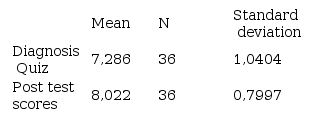
These results are corroborated by statistical software, determining that Differentiated Instruction has a positive impact on Reading skills development of A1 level students observed. The Student´s t -test distribution for the experimental group is presented as follows:
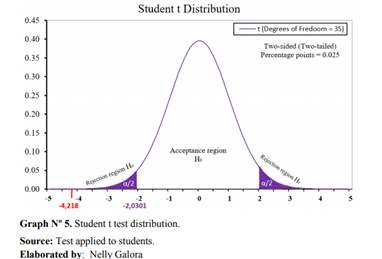
The Implementation of Differentiated Instruction had a positive impact on the reading skills. For instance, there was a great expansion on students? vocabulary. The students were able to use more frequent words in their writing activities. At the same time, students? motivation for reading increased while students took an active role in the reading lessons with a lower level of anxiety, which was reduced because they worked under different modalities like individual reading, pair reading, group discussion reading and reading fluency groups. They encountered passages which met their reading ability level. It has been proved that selecting reading materials that meet students? interest have increased their motivation for reading, students showed active involvement and engagement during the reading activities.
Teaching reading skills through the implementation of Differentiated Instruction involves knowing how the type of assignments work in the classroom. Therefore, it is important that teachers know what their students? reading abilities are, as well as what learners like reading. Additional research needs to be conducted with students of higher levels to see and confirm the benefits of the implementation of Differentiated instruction on the development of reading skills.











